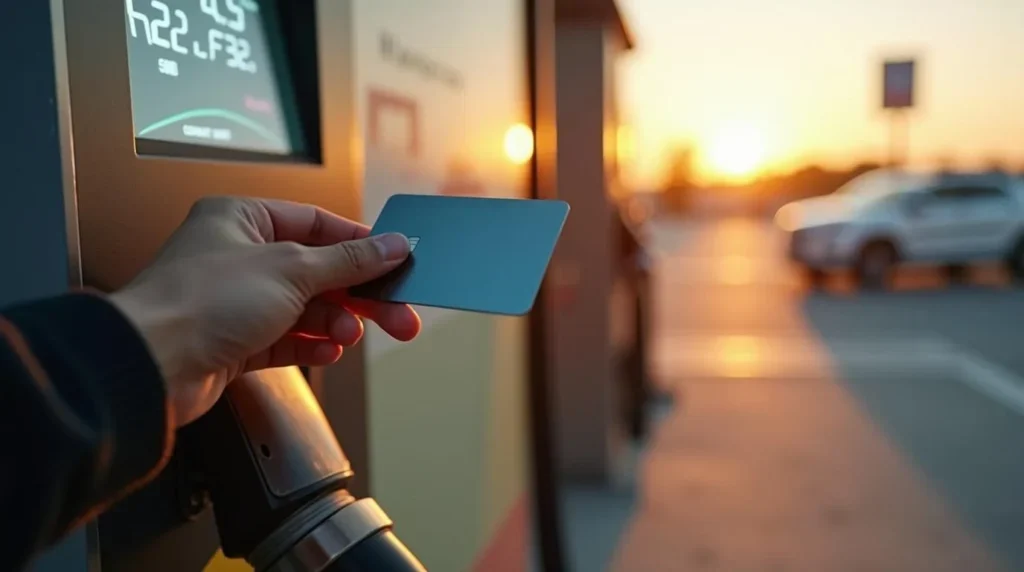What happens when prices surge at the pump? Gas cards can prevent budget blowouts and streamline savings, rewards, and expense management at fuel stations. These specialized payment tools offer more than convenience—they create a structured approach to managing fuel expenses while earning rewards. Sunoco gas cards are an example of how fuel payment solutions combine discounts, cashback opportunities, and digital features to transform routine fill-ups into strategic savings opportunities.
What Are Gas Cards and How Do They Work?
Fuel payment cards function as dedicated tools for purchasing gasoline, diesel, and often convenience store items at participating stations. These products fall into three main categories: branded credit cards tied to specific fuel networks, universal cards accepted across multiple chains, and prepaid options loaded with predetermined balances. Each type processes transactions differently, with credit versions extending revolving credit lines while prepaid and gift card variants deduct from existing balances.
The mechanics involve swiping or inserting the card at the pump or inside the station, with transactions posting to your account immediately or within 24-48 hours. Many issuers provide mobile apps for balance monitoring, payment scheduling, and locating nearby participating locations. Business versions often include additional controls like purchase limits, restricted hours, and product-specific authorizations.
Unlocking Gas Card Benefits and Features
Fuel Discounts and Reward Points Explained
Most fuel payment programs offer immediate per-gallon discounts ranging from 3 to 10 cents, applied automatically at checkout. Points accumulate based on dollar amounts spent, typically earning 1-5 points per dollar at participating stations. These rewards often double or triple during promotional periods, with some networks offering bonus earnings for purchases inside convenience stores.
Redemption options vary by issuer, with points converting to statement credits, free gallons, or merchandise. Some programs maintain tiered structures where higher spending unlocks enhanced earning rates. For instance, reaching $500 in monthly fuel purchases might boost your discount from 5 to 8 cents per gallon for the following billing cycle.
Cashback, Loyalty, and Special Offers
Cashback percentages typically range from 2% to 5% on fuel purchases, with some cards offering rotating quarterly categories reaching 6% or higher. Loyalty benefits extend beyond basic earnings, incorporating birthday bonuses, anniversary rewards, and exclusive member pricing on car washes or maintenance services. Special offers frequently appear through issuer apps, including double points weekends, bonus cashback on first fills each month, or partnerships with restaurants and retailers near station locations.
Mobile Apps and Digital Convenience
Digital platforms revolutionize account management, enabling instant balance checks, transaction histories, and payment scheduling from smartphones. Location services help drivers find the nearest participating stations with real-time price comparisons. Many apps integrate digital wallets, allowing contactless payment at equipped pumps while maintaining reward earnings and discount applications.
Gas Cards in Unpredictable Situations
What Happens When Prices Surge? Preventing Budget Blowouts
During price spikes, fuel payment programs shield budgets through locked-in discounts and enhanced rewards that offset rising costs. Fixed per-gallon savings become increasingly valuable as base prices climb, while percentage-based cashback automatically adjusts upward with higher purchase amounts. Some issuers activate emergency promotions during extreme price volatility, temporarily boosting discounts or removing transaction fees.
Prepaid options provide absolute spending control by limiting purchases to loaded amounts, preventing overspending regardless of market conditions. Business accounts benefit from preset monthly limits that automatically restrict transactions once thresholds are reached, maintaining expense predictability even when fuel costs fluctuate dramatically.
Purchase Controls, Transaction Limits, Fraud Prevention
Security features include real-time alerts for every transaction, geographic restrictions limiting usage to specific regions, and product controls blocking non-fuel purchases. Daily and per-transaction limits prevent unauthorized large purchases, while PIN requirements add authentication layers at the pump. Advanced fraud detection systems flag unusual patterns, such as multiple fills within short timeframes or transactions in unexpected locations.
Business solutions offer driver-specific cards with customized restrictions, enabling managers to set individual limits, approved station networks, and authorized purchase categories. Instant deactivation through mobile apps protects accounts when cards are lost or stolen, while zero-liability policies shield cardholders from fraudulent charges.
Comparing Top Gas Cards and Networks
Universal vs. Brand-Specific Cards: Network Acceptance
Universal fuel payment options work across multiple brands, offering flexibility for drivers who travel extensively or lack convenient access to specific chains. These typically provide lower per-gallon discounts but compensate with broader acceptance and consistent rewards regardless of station choice. Brand-specific alternatives deliver deeper discounts at affiliated locations, often 10-25 cents per gallon, but limit savings to single networks.
Network size varies significantly, with major chains like Shell, Chevron, and BP operating thousands of U.S. locations while regional players focus on specific markets. Universal acceptance depends on payment processor partnerships, with Visa and Mastercard-backed options accepted virtually everywhere while proprietary fleet cards may restrict usage to contracted stations.
Fee Structures, Card Types (Credit, Prepaid, Gift)
Annual fees range from zero for basic consumer cards to several hundred dollars for premium business accounts with enhanced benefits. Credit versions may charge interest on carried balances, typically 15-25% APR, while prepaid and gift alternatives avoid interest but sometimes include activation or reload fees. Foreign transaction fees apply when using cards internationally, usually 2-3% of purchase amounts.
Maintenance fees on prepaid options vary by issuer, with some charging monthly service fees after periods of inactivity. Gift cards generally avoid ongoing fees but may expire after predetermined periods. Business accounts often include per-card fees for additional driver cards, though volume discounts apply for larger fleets.
Sunoco and Other Major Issuers—Key Differences
Sunoco’s program emphasizes mobile app integration and instant savings at over 5,000 locations nationwide, with particular strength in eastern markets. Shell’s offerings focus on premium tier rewards and international acceptance, while Exxon Mobil prioritizes simplicity with straightforward cents-per-gallon discounts. Chevron distinguishes itself through Techron additive benefits messaging and West Coast market dominance.
Regional players like Wawa and Sheetz combine fuel savings with convenience store loyalty programs, creating comprehensive rewards ecosystems. Walmart’s fuel program leverages its retail presence, offering discounts at both Murphy USA and Walmart-branded stations while integrating with broader shopping rewards.
Business and Fleet Solutions
Streamlining Expenses and Billing
Commercial fuel programs consolidate multiple vehicle expenses into single monthly statements, eliminating receipt collection and manual expense reports. Automated billing cycles align with accounting periods, while detailed transaction logs identify spending by driver, vehicle, location, and time. Electronic invoicing reduces paperwork while improving accuracy and processing speed.
Customizable reporting breaks down costs by department, project, or client, facilitating accurate job costing and budget allocation. Integration with accounting software automates data transfer, reducing manual entry errors and accelerating month-end closings. Some platforms offer split billing capabilities, separating fuel from maintenance or other authorized purchases.
Usage Tracking, Reporting, App Integration
Real-time dashboards display fleet activity, including current locations, recent transactions, and spending trends. Automated reports highlight anomalies like excessive idling, route deviations, or unusual purchase patterns. Mobile apps enable managers to approve exceptions, adjust limits, or respond to driver requests instantly.
Advanced analytics identify optimization opportunities, such as redirecting drivers to lower-priced stations or consolidating purchases for volume discounts. Mileage tracking correlates fuel consumption with distance traveled, flagging potential maintenance issues or inefficient driving behaviors. API connections enable seamless data flow between fuel programs and fleet management platforms.
How Rewards and Savings Work for Everyday Consumers
Typical Earnings: Points, Cashback, Free Merch
Average consumers filling up weekly can accumulate 500-2,000 points monthly, translating to $5-20 in rewards depending on program structures. Cashback earnings on $200 monthly fuel spending at 3% yield $72 annually, while 5% returns generate $120. Merchandise redemptions often include automotive accessories, electronics, or gift cards to popular retailers, with point values varying by item selection.
Promotional periods amplify earnings potential, with quarterly bonuses potentially doubling or tripling standard accumulation rates. Birthday months, anniversary celebrations, and holiday promotions create additional earning opportunities. Some programs offer referral bonuses, rewarding existing members for bringing new customers into the network.
Loyalty Bonuses and Redemption Strategies
Strategic redemption maximizes value by timing point usage during promotional periods when redemption rates improve. Banking points for larger rewards often yields better value than frequent small redemptions. Combining fuel rewards with credit card cashback or retail loyalty programs creates stacked savings exceeding 10% on total purchases.
Status tiers reward consistent usage with enhanced benefits like premium customer service, exclusive offers, or accelerated earning rates. Annual spending thresholds unlock perks such as free car washes, complimentary beverages, or priority pump access during peak hours. Some networks offer surprise bonuses, randomly selecting members for free tanks or significant point deposits.
Choosing the Right Gas Card for Your Needs
What To Look For: Comparison Checklist
Essential evaluation criteria include network coverage in your regular driving areas, discount structures matching your consumption patterns, and fee arrangements aligned with usage frequency. Consider whether you prefer immediate per-gallon savings or accumulated rewards for future redemption. Assess mobile app functionality, customer service availability, and integration with existing financial tools.
Secondary factors encompass additional benefits like roadside assistance, purchase protection, or travel insurance. Review terms regarding expired rewards, account inactivity penalties, and balance transfer options. Understand dispute resolution processes, liability limits, and security features protecting against unauthorized usage.
Beyond the Pump: Other Perks and Services
Many programs extend benefits beyond fuel purchases, offering discounts on vehicle maintenance, car rentals, and hotel bookings. Convenience store savings apply to snacks, beverages, and automotive supplies, effectively expanding reward opportunities. Partnership networks provide access to exclusive deals at restaurants, entertainment venues, and retail stores near participating stations.
Premium tiers sometimes include concierge services, travel planning assistance, or exclusive event access. Environmental programs allow point donations to conservation organizations or carbon offset purchases. Community features connect members through forums, local meetups, or charity drives, creating engagement beyond transactional relationships.
Selecting optimal fuel payment solutions requires balancing immediate savings against long-term value accumulation while considering convenience factors and network accessibility. Whether prioritizing simple per-gallon discounts, maximizing cashback percentages, or accessing comprehensive business management tools, matching program features to specific needs ensures maximum benefit realization. Regular evaluation of changing driving patterns, fuel consumption trends, and available alternatives maintains alignment between chosen solutions and evolving requirements.

Lexy Summer is a talented writer with a deep passion for the art of language and storytelling. With a background in editing and content creation, Lexy has honed her skills in crafting clear, engaging, and grammatically flawless writing.



